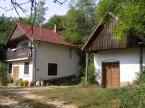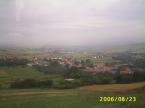Information
Hunedoara (Hungarian: Vajdahunyad, German: Eisenmarkt) is a city in Hunedoara County, Romania, in the Transylvania region. It is in the Cerna Valley near the Poiana Rusca Mountains within the Transylvanian Alps.
The city of Hunedoara has the most important Gothic-style secular building in Romania: Hunyadi Castle, which is closely connnected with the Hunyadi family. The castle was originally a small royal citadel and was given to Vajk (Romanian: Voicu) by King Sigismund of Hungary in 1409. Vajk's son, John Hunyadi, began enlargement of the castle into a Gothic residence in 1446. The castle was damaged by fire three times, but underwent successive renovations in the late 19th and early 20th centuries by the architects, Imre Steindl, Frigyes Schulek and István Möller.
Besides the Romanian population, there are also ethnic Hungarians and Germans living in Hunedoara. Roma population also thrives in a small village near the town, called Hasdat. The city contains many green gardens and old trees flank the streets. The castle has been turned into a museum, following recent reconstruction. A large dam, with tourist facilities, is located a few kilometres from the city, up in the mountains. A big and nice hotel, recently rennovated, lies in the city center.
During the 20th century, Hunedoara increased its population to 86,000 inhabitants. The city used to contain the second largest steel works in Romania, but this has now closed down. However, the economy of the city is now benefiting from new investment.
History
Where the city of Hunedoara stands today, stone age tools were discovered in the hill near the castle called Sanpetru (Saint Peter) and in the surrounding villages. The region was very rich in iron and had been extracted in the area since the Iron Age of Thracians and later, in the Thracian and Roman times. The remains of eight dacian iron furnaces have been found at the Sanpetru hill near the castle. The proximity of the town to the network of fortresses and temples in the mountains of Orastie, and the discovery of important monetary treasures of dacian coins and Roman imperial coins, testify to the importance of this site.After Dacia was conquered around 102 AD and turned into a Roman province, the iron-rich region attracted the attention of the Romans, who begun to exploit it by building furnaces. A "Villa Rustica" emerged in Teliuc, a Roman castrum on Sanpetru hill, outpost of the legio XII Gemina. Other Roman artifacts were discovered in the town area, and also in Pestis, where the remains of a Roman village were discovered.
After the Roman military and administrative retreat due to migrations of people from the east in 267 AD, the romanized and christianized population continued to thrive in the mountains and isolated valleys and was able to keep faith and connections with the Byzantine Empire and the civilized world. This is attested by discoveries of artifacts and christian burring places around the town. Thus Romanians were born, in the passing of time. Around 1000 AD, small political feuds arose and Transylvania fell under the Hungarian Kingdom and became part of it. Later on, an autonomous principate arose, with populations of Romanians, Hungarians, Szeklers and Saxons.
The first recorded evidence of the town was made in 1265 under the name Hungnod as a hub for leather tanning and wool processing. The town of Hunedoara became an important iron extracting and processing center in Transylvania. "Corpus Inscriptiorum Latinorum" refers to a local inhabitant as "natas ibi, ubi ferum nascitur", that is, "born where the iron was born". The swords and spears, made in the 14th and 15th centuries in the iron foundries and works, were famous for their stiffness in a period of intense fighting with the Ottoman Turks.
The town is mainly known since the 14th century as the residence of the Corvin family. On October 18, 1409, Voicu, a Romanian from Wallachia, was rewarded for military bravery by Sigismund of Luxembourg, and received the domain of Hunedoara. The same document mentions Mogos, Radu and Iancu, sons of Voicu. Ioannus Corvinus (Ianos Hunyadi) (Iancu Corvin de Hunedoara), the son of Voicu, spent his childhood here. He married Elisabeta, a Hungarian princess, and advanced to be named principal ruler of Transylvania, which was by then an autonomous part of the kingdom of Hungary. He consolidated the citadel, on the top of an ancient fortress and took care of the small city. He studied military in the Italian republics, and became the most skilful warrior of Hungary. Named governor of Hungary, he engaged in crusades against the Turks, and the victories reputed there by coalitions of Serbian, Romanian and Hungarian forces of the region, with the help from European lords, managed to secure the Hungarian kingdom from the Turks for more than two centuries. After he died in a military camp after his biggest military triumph, his son, Matei (Matias Rex) later became the most famous Hungarian king, and he also consolidated the castle and the feudal domain of Hunedoara. The castle of Hunedoara became one of the biggest in the world, standing as a witness to the greatness of this family of noble warriors and statesmen, in an era of war and despair, as the Ottoman Empire approached Central Europe.
In the times of Corvins, Hunedoara became a market (opidum) for iron. Matei Corvin named the city a tax-free area, and this privilege extended until the 17th century. The population varied between 784 people in 1512 and 896 people in the 17th century. After Matei died, Hunedoara was owned by his son, Ioan, but he too died young. His wife, Beatrice de Frangepan, married Georg of Hohenzolern, Marquis of Brandenburg in 1509. But Georg de Brandenburg would not establish in Hunedoara, instead naming a representative, Gyorgy Stolcz.
In 1514, the rebellion of György Dózsa made Romanian and Hungarian peasants to revolt, and some of them were imprisoned in the castle. The 17th century ruler of Transylvania, Gabriel Bethlem, also extended the castle. Hunedoara had a catholic cathedral built around 1600 and a smaller orthodox church for the Romanian population.
The first tall industrial furnace in the world for iron extracting, it has been argued, was built in 1750 in Toplita near Hunedoara, and a later one in Govajdia in 1806. Both furnaces can be visited today. To arrive to it, there is a system of narrow-gauge railway built in the 19th and 20th centuries that still runs today through the breathtaking landscape of "Tara Padurenilor" (Woodlanders' country).
In the 19th century, Hunedoara became more and more industrialized, peasants from regions nearby began to move to the city and the population increased. As the Romanian nation was underpriviledged, it revolted a few times. The peasants supported the Horea, Closca and Crisan rebellion, and the Avrama Iancu resistance in Apuseni mountains. Transylvania was given to the kingdom of Romania after the World War I. The Romanian populations in and around the town quickly earned political rights and representation, and industrial development continued at an ever-increasing rate.
In the communist regime years, industry was favored, and Hunedoara had for a time the biggest steel-producing factory in Romania and even the Balkans. The town grew larger, and the factories extended so much that accounted the same size as the city, or even more. The population also increased to over 87,000. The football team, Corvin, was for a very long time one of the highest-rated football teams in Romania, rivaling Steaua or Dinamo. A big stadium was built with lots of other sports facilities, such as covered swimming pools and a skating ring.
The communist collapse meant that the old markets for steel had vanished, and a lot of enterprises had to be closed or abandoned. More than half of the population lost their jobs. However, investment from Romanian and foreign capital ventures has started offering new job opportunities to the people.
Neighborhood and attractions
The Corvins Castle
The Castle is also known by the name, "Huniazi Castle". "Huniazi" is a more international name for the same family, "Corvins" being used only by Romanians and Hungarians.The impressive size and architectural beauty sets it among the most precious monuments of medieval art, subsequent developments mixing Gothic style with Renaissance and Baroque. The building lies on a rock, around which flows the river, Zlasti. It has an impressive bridge, countless towers, a number of interior courts, and two large halls, "Knight Hall" and "Diet Hall", as it housed the diet of Transylvania for a very short period.
The castle history is mostly related to the Huniazi family, being the place where Iancu de Hunedoara spent his chilhood. Today the castle is being cared for by the municipality, as there are no recorded descendants of the Huniazi that could pledge for it. Tepes, the ruler of Wallachia, internationally known as Dracula, stood here imprisoned, as he had fallen into disgrace of Huniazi, not providing the help promised on the battle against the Turks. The castle and surroundings are often used by international film companies, for the production of movies about medieval times.
The Iron Museum
Oak Forest of Chizid
Standing on a hill near Hunedoara, this is also a spot to get a panoramic view of the city.
Hunedoara Zoo
Located near the forest of Chizid, the zoo houses not only tigers, lions, bears, wolves, but also chicken and frogs, and a pony, named George.
Cincis Accumulation Lake
Built around the 1950s at the Cerna river, it developed into a small resort for Romanians and foreign tourists.
The Poiana Ruscai Mountains
Vast and easily accessible by foot or by car, the mountains are inhabited by an ancient population of Romanians, called padureni (woodlanders). They retained a specific culture and a sense of identity and held a number of festivals annually. The Romans exploited marbles in the quarry nearby.
The Nandru Caves
The caves contain neanderthalian culture, artifacts and burial grounds.
The Pestis Roman Ruins
The Paleontological Natural Reservation of Buituri and Nandru
The natural reservation contains fossilized snails and fish.
The Olympic Swimming Pools
The pools have been modernized.

 English
English









